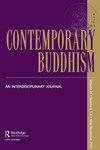Traditional and Modern Meditation Practices in Shan Buddhist Communities
IF 0.1
3区 哲学
0 PHILOSOPHY
引用次数: 1
Abstract
ABSTRACT This article explores how meditation is inculcated throughout the life of Shan Buddhists using poetic phrasing and texts, culminating in several forms of meditation as part of the practice of temple-sleeping undertaken by lay Buddhist seniors from the age of 40 upwards. I look at how the poetic texts, lik loung, that form the basis of temple-sleeping practice, may have shifted in content in the 19th to 20th centuries to focus on meditation topics, in a move parallel to the development of vipassanā in lowland Burma in reaction to the threat colonialism posed to Buddhism. I then document the rise of separate vipassanā meditation centres in Shan regions from the 1930s and their ambiguous status as either representatives of Burmese hegemony or drivers of Shan revival. I note the influence of Shan lik loung on practice at such centres, as well as a more recent development, the uptake of vipassanā within temple-sleeping contexts.掸邦佛教社区的传统与现代禅修
摘要:本文探讨了如何在掸邦佛教徒的一生中使用诗意的措辞和文本来灌输冥想,最终形成了几种形式的冥想,作为40岁以上的佛教长老进行的寺庙睡眠实践的一部分。我观察了作为寺庙睡眠实践基础的诗歌文本lik loung在19世纪至20世纪的内容可能发生了怎样的变化,以专注于冥想主题,这与缅甸低地的毗婆沙的发展相平行,以应对殖民主义对佛教构成的威胁。然后,我记录了自20世纪30年代以来,掸邦地区独立的毗婆沙禅修中心的兴起,以及它们作为缅甸霸权代表或掸邦复兴推动者的模糊地位。我注意到Shan lik loung对这些中心的实践的影响,以及最近的一个发展,即在寺庙睡眠环境中对毗婆沙的吸收。
本文章由计算机程序翻译,如有差异,请以英文原文为准。
求助全文
约1分钟内获得全文
求助全文

 求助内容:
求助内容: 应助结果提醒方式:
应助结果提醒方式:


